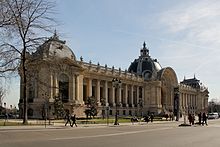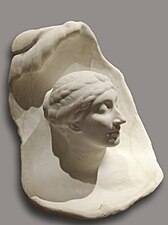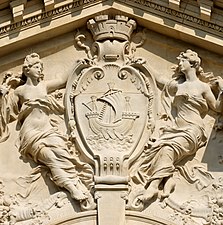
Art Nouveau is an international style of art, architecture, and applied art, especially the decorative arts. It was often inspired by natural forms such as the sinuous curves of plants and flowers. Other characteristics of Art Nouveau were a sense of dynamism and movement, often given by asymmetry or whiplash lines, and the use of modern materials, particularly iron, glass, ceramics and later concrete, to create unusual forms and larger open spaces. It was popular between 1890 and 1910 during the Belle Époque period, and was a reaction against the academicism, eclecticism and historicism of 19th century architecture and decorative art.

The Exposition Universelle of 1900, better known in English as the 1900 Paris Exposition, was a world's fair held in Paris, France, from 14 April to 12 November 1900, to celebrate the achievements of the past century and to accelerate development into the next. It was the sixth of ten major expositions held in the city between 1855 and 1937. It was held at the esplanade of Les Invalides, the Champ de Mars, the Trocadéro and at the banks of the Seine between them, with an additional section in the Bois de Vincennes, and it was visited by more than fifty million people. Many international congresses and other events were held within the framework of the exposition, including the 1900 Summer Olympics.
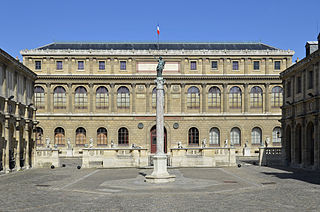
The Beaux-Arts de Paris, formally the École nationale supérieure des beaux-arts, is a French grande école whose primary mission is to provide high-level fine arts education and training. The art school, which is part of the Paris Sciences et Lettres University, is located on two sites: Saint-Germain-des-Prés in Paris, and Saint-Ouen.

Hector Guimard was a French architect and designer, and a prominent figure of the Art Nouveau style. He achieved early fame with his design for the Castel Beranger, the first Art Nouveau apartment building in Paris, which was selected in an 1899 competition as one of the best new building facades in the city. He is best known for the glass and iron edicules or canopies, with ornamental Art Nouveau curves, which he designed to cover the entrances of the first stations of the Paris Metro.

Beaux-Arts architecture was the academic architectural style taught at the École des Beaux-Arts in Paris, particularly from the 1830s to the end of the 19th century. It drew upon the principles of French neoclassicism, but also incorporated Renaissance and Baroque elements, and used modern materials, such as iron and glass, and later, steel. It was an important style and enormous influence in Europe and the Americas through the end of the 19th century, and into the 20th, particularly for institutional and public buildings.
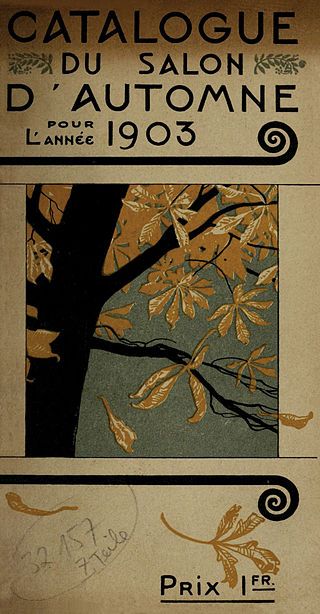
The Salon d'Automne, or Société du Salon d'automne, is an art exhibition held annually in Paris. Since 2011, it is held on the Champs-Élysées, between the Grand Palais and the Petit Palais, in mid-October. The first Salon d'Automne was created in 1903 by Frantz Jourdain, with Hector Guimard, George Desvallières, Eugène Carrière, Félix Vallotton, Édouard Vuillard, Eugène Chigot and Maison Jansen.

The International Exhibition of Modern Decorative and Industrial Arts was a specialized exhibition held in Paris, France, from April to October 1925. It was designed by the French government to highlight the new modern style of architecture, interior decoration, furniture, glass, jewelry and other decorative arts in Europe and throughout the world. Many ideas of the international avant-garde in the fields of architecture and applied arts were presented for the first time at the exposition. The event took place between the esplanade of Les Invalides and the entrances of the Grand Palais and Petit Palais, and on both banks of the Seine. There were 15,000 exhibitors from twenty different countries, and it was visited by sixteen million people during its seven-month run. The modern style presented at the exposition later became known as "Art Deco", after the exposition's name.
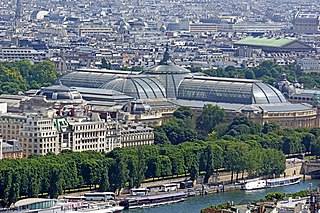
The Grand Palais des Champs-Élysées, commonly known as the Grand Palais, is a historic site, exhibition hall and museum complex located in the 8th arrondissement of Paris between the Champs-Élysées and the Seine, France. Construction of the Grand Palais began in 1897 following the demolition of the Palais de l'Industrie to prepare for the Universal Exposition of 1900. That exposition also produced the adjacent Petit Palais and Pont Alexandre III.

Jean-Antoine Injalbert (1845–1933) was a much-decorated French sculptor, born in Béziers.
Claude Monet painted several series of nearly 100 impressionist oil paintings of different views of the Thames River in the autumn of 1899 and the early months of 1900 and 1901 during stays in London. One of these series consists of views of the Palace of Westminster, home of the British Parliament, and he began the first of these paintings at about 15.45 on 13 February 1900. All of the series' paintings share the same viewpoint from Monet's window or a terrace at St Thomas' Hospital overlooking the Thames and the approximate canvas size of 81 cm × 92 cm. They are, however, painted during different times of the day and weather conditions.

The Palais Rohan in Strasbourg is the former residence of the prince-bishops and cardinals of the House of Rohan, an ancient French noble family originally from Brittany. It is a major architectural, historical, and cultural landmark in the city. It was built next to Strasbourg Cathedral in the 1730s, from designs by Robert de Cotte, and is considered a masterpiece of French Baroque architecture. Since its completion in 1742, the palace has hosted a number of French monarchs such as Louis XV, Marie Antoinette, Napoleon and Joséphine, and Charles X.

The Fine Arts Museum of Nantes, along with 14 other provincial museums, was created, by consular decree on 14 Fructidor in year IX. Today the museum is one of the largest museums in the region.

Charles-Louis Girault was a French architect.

A medallion is a round or oval ornament that frames a sculptural or pictorial decoration in any context, but typically a façade, an interior, a monument, or a piece of furniture or equipment.
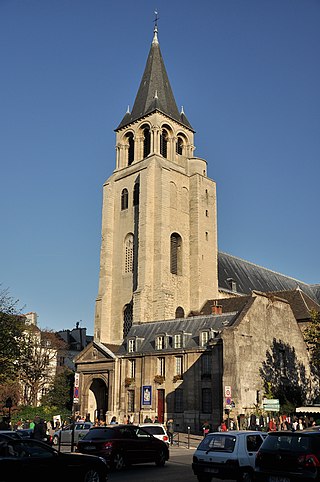
The city of Paris has notable examples of architecture from the Middle Ages to the 21st century. It was the birthplace of the Gothic style, and has important monuments of the French Renaissance, Classical revival, the Flamboyant style of the reign of Napoleon III, the Belle Époque, and the Art Nouveau style. The great Exposition Universelle (1889) and 1900 added Paris landmarks, including the Eiffel Tower and Grand Palais. In the 20th century, the Art Deco style of architecture first appeared in Paris, and Paris architects also influenced the postmodern architecture of the second half of the century.

Jeanne-Henriette Tirman was a French woman painter and printmaker.

The architecture of Paris created during the Belle Époque, between 1871 and the beginning of the First World War in 1914, was notable for its variety of different styles, from neo-Byzantine and neo-Gothic to classicism, Art Nouveau and Art Deco. It was also known for its lavish decoration and its imaginative use of both new and traditional materials, including iron, plate glass, colored tile and reinforced concrete. Notable buildings and structures of the period include the Eiffel Tower, the Grand Palais, the Théâtre des Champs-Élysées, the Gare de Lyon, the Bon Marché department store, and the entries of the stations of the Paris Metro designed by Hector Guimard.
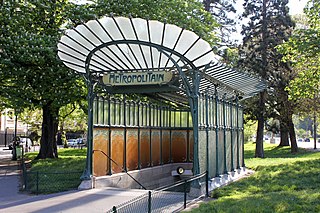
The Art Nouveau movement of architecture and design flourished in Paris from about 1895 to 1914, reaching its high point at the 1900 Paris International Exposition. with the Art Nouveau metro stations designed by Hector Guimard. It was characterized by a rejection of historicism and traditional architectural forms, and a flamboyant use of floral and vegetal designs, sinuous curving lines such as the whiplash line, and asymmetry. It was most prominent in architecture, appearing in department stores, apartment buildings, and churches; and in the decorative arts, particularly glassware, furniture, and jewelry. Besides Guimard, major artists included René Lalique in glassware, Louis Majorelle in furniture, and Alphonse Mucha in graphic arts, It spread quickly to other countries, but lost favor after 1910 and came to an end with the First World War.

The whiplash or whiplash line is a motif of decorative art and design that was particularly popular in Art Nouveau. It is an asymmetrical, sinuous line, often in an ornamental S-curve, usually inspired by natural forms such as plants and flowers, which suggests dynamism and movement. It took its name from a woven fabric panel "Cyclamen", by the German artist Hermann Obrist (1895) which depicted the stems and roots of the cyclamen plant, which critics dubbed "Coup de Fouet" ('whiplash'). The panel was later reproduced by the textile workshop of the Darmstadt Artists Colony.
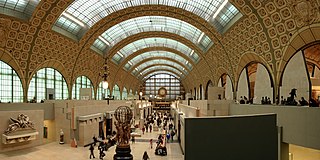
The 136 museums in the city of Paris display many historical, scientific, and archeological artifacts from around the world, covering diverse and unique topics including fashion, theater, sports, cosmetics, and the culinary arts.



